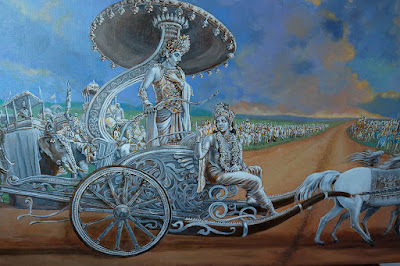Vishnu, Shiva, and Brahma, oil painting on linen canvas 40 inches by 44 inches. (This image is under strict copyright to Dominique Amendola. )
This painting is painted in a classical style using the Venitian painters techniques such as Titian, the medieval Renaissance Italian artist. It represents Lord Brahma explaining the Vedas or the mystical nature of the Absolute to Lord Shiva taking his inspiration from Lord Vishnu. The Vedic scriptures are the spiritual texts of Ancient India, written in the Sanscrit language.
In this painting, I have used the
scumbling method in the
underpainting mostly. The underpainting is executed with acrylics. It helps to establish the foundation for the whole artwork. I have my own way to paint and I am not claiming this is a demo for the Venetian technique of the Renaissance. However, I really think it is close to it, with the difference that for their underpainting, they used
tempera.
I have always begun such an elaborate composition with numerous sketches. This is a commissioned artwork for the publication of one of the Upanishads, a Vedic text of ancient India.
Here are the first few steps:
I first figure out the basic composition. This sketch looks like nothing, but it has the correct ratio for my final painting, and the composition is based on the golden section.
Each figure will then be elaborately sketched and the background studied.
This is an example of how the sketch for Brahma progressed.
Shiva and Visnu came next.
Even so, you can see very little of Shiva's chair in the final painting, I designed it entirely so I could cover it with a tiger skin in a believable manner.
The tiger skin took many shapes, but in the end, I used my imagination to make it look believable.
After many steps, the sketch was ready to be transferred on the canvas.
I also produced a tone sketch and a color sketch before starting to paint so that I knew clearly where the light would fall and how the colors would go.
The Steps for the Acrylic layer.
My canvas was toned first with a Venitian red.
This a large painting. I first transferred the final sketch to the toned canvas. Then started to establish the values. As you can see, because the canvas is toned with a dark color, I start with the lights.
This is the acrylic layer before it was scumbled. The scumbling is done with white and I do not show that step. but if you enlarge the cloud where Vishnu lies, you will see how the thin layer of white has created some beautiful grays. That is the whole idea for using that red earth color. Once scrambled, it creates incredible gray tones and you can establish your gray layer on top of that. In the end, the colors will vibrate with a lot of depths from that technique.
Here I started the gray layer on Brahma. notice the scumbled layer from the previous step on Shiva
The gray layer is applied to the skin colors. All the layers are glazed step by step.
Gray layer finished over Shiva, more and more layers of colors and details are being refined.
More colors, more details are applied
Refining the details
Now you can see more details about the finished artwork:
I kept Lord Vishnu blurred because He belongs to Lord Brahma's vision.
Painting is a meditation.
The original artwork is available.
To purchase the painting click here:
ORIGINAL ARTWORK
You can get all sort of prints from me_canvas prints, framed print, art print, metal print, wood print and more for this painting.
To purchase a print of this painting, click here:
TO SEE MORE ART GO TO MY SITE:
Dominique Amendola-California, US, India, France, Classical realism and impressionism figures and landscapes painter



















































